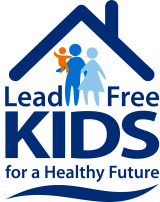Lead Free Kids: National Lead Poisoning Prevention Week 2017
Posted on byJessica and Ben had their first child one month ago, and just bought a 1959 Midcentury-modern ranch style house. They want to do some renovation before moving in, but they know that homes built before 1978 often contain lead paint. They also know that even though exposures to lead in tap water have been greatly reduced during the last two decades, lead still can be found in some metal water taps, interior water pipes, pipes connected with lead solder, and pipes connecting a house to the main water pipe in the street.
Although the sellers made no disclosures about lead paint or lead in tap water and the inspection revealed no issues, Jessica and Ben still want to be sure the home is safe for their baby. Because they know that no safe blood lead level in children has been identified, the couple are not going to take any chances with their baby’s health. They find some helpful information on the U.S. Environmental Protection Agency (EPA) website:
- On the Renovation, Repair and Painting Program: Do-It-Yourselfers page, they learn that even if old lead-based paint is covered by layers of newer paint, stripping or sanding the surface could release hazardous lead dust. Jessica and Ben decide to hire a certified lead renovation, repair, and painting (RRP) contractor to remove any lead hazards from their home. RRPs are trained to reduce the chance of lead contamination by minimizing dust and cleaning thoroughly—and they can do the painting, too!
- On the Basic Information about Lead in Drinking Water page, they learn how to get a quality report on the water coming into their house, and how to test their water for lead. Jessica and Ben decide to contact their community water system for a copy of their latest quality report, and find a testing laboratory in their state on EPA’s page Contact Information for Certification Programs and Certified Laboratories for Drinking Water.
Jessica and Ben know they can cut back on renovation costs elsewhere to pay for the contractors to remove lead hazards from their home. What is most important is giving their new baby a clean, safe, lead-free home.
Facts about lead exposure
- Lead-based paint and lead-contaminated dust are the most hazardous sources of lead for U.S. children.
- Houses built before lead-based paints were banned in 1978 are likely to contain some lead-based paint.
- About 24 million homes in the U.S. contain deteriorated lead-based paint and elevated levels of lead-contaminated house dust.
- The Safe Drinking Water Act (http://www.epa.gov/sdwa) and EPA’s Lead and Copper Rule (http://www.epa.gov/dwreginfo/lead-and-copper-rule) have greatly reduced exposures to lead in tap water.
- Lead found in tap water usually comes from the corrosion of older fixtures or from the solder that connects pipes.
- About 4 million homes with elevated lead levels are home to young children.
- An estimated 535,000 U.S. children ages 1-5 years have blood lead levels ≥5 µg/dL which is known to damage health.
- For each seriously lead-poisoned child, medical and special education costs average over $5,600.
Click here for the CDC’s lead poisoning prevention infographic.
Other sources of lead exposure
Children can come into contact with lead in some toys and toy jewelry, imported candy, and traditional home remedies. In addition, adults who work in occupations involving lead, such as mining or manufacturing, may accidentally bring lead into their homes from products they use at work. Some hobbies, like making stained glass, also use lead.
Dangers to children’s health from lead exposure
Exposure to lead can seriously harm a child’s health. Even at low levels, lead exposure can cause damage to the brain and nervous system, slowing growth and development and lowering IQ. It can lead to problems with hearing and speech, behavior, paying attention, and learning.
The great news is that lead poisoning is 100% preventable. Follow these steps to make your home lead-safe:
- If you have concerns about your child’s exposure to lead, talk to your child’s doctor about a simple blood lead test. CDC recommends blood lead testing at 1 and 2 years, with particular focus on children living in communities with a lot of older housing and high rates of poverty and children who are Medicaid-eligible.
- Talk to your local health department about testing paint and dust in your home for lead if you live in a home built before 1978.
- If your house has lead paint, renovate safely by hiring a certified lead renovation, repair, and painting (RRP) contractor.
- Get the latest quality report from your community water system and decide if you want to test your water for lead by a certified laboratory.
- Remove recalled toys and toy jewelry from children. Stay up-to-date on current toy and toy jewelry recalls by visiting the Consumer Product Safety Commission’s webpage.
Resources
- CDC’s Lead-Information for Parents
- CDC’s Prevention Tips
- CDC’s Lead webpage
- Agency for Toxic Substances and Disease Registry’s ToxFAQs for Lead
- EPA’s Lead webpage
- U.S. Department of Housing and Urban Development’s Office of Lead Hazard Control and Healthy Homes webpage
- Consumer Product Safety Commission’s webpage (to stay up-to-date on current toy and toy jewelry recalls)



Post a Comment